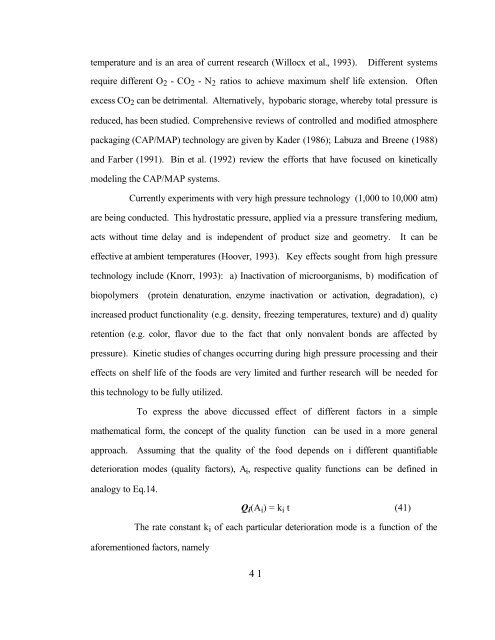the handbook of food engineering practice crc press chapter 10 ...
the handbook of food engineering practice crc press chapter 10 ...
the handbook of food engineering practice crc press chapter 10 ...
Create successful ePaper yourself
Turn your PDF publications into a flip-book with our unique Google optimized e-Paper software.
temperature and is an area <strong>of</strong> current research (Willocx et al., 1993). Different systems<br />
require different O 2 - CO 2 - N 2 ratios to achieve maximum shelf life extension. Often<br />
excess CO 2 can be detrimental. Alternatively, hypobaric storage, whereby total <strong>press</strong>ure is<br />
reduced, has been studied. Comprehensive reviews <strong>of</strong> controlled and modified atmosphere<br />
packaging (CAP/MAP) technology are given by Kader (1986); Labuza and Breene (1988)<br />
and Farber (1991). Bin et al. (1992) review <strong>the</strong> efforts that have focused on kinetically<br />
modeling <strong>the</strong> CAP/MAP systems.<br />
Currently experiments with very high <strong>press</strong>ure technology (1,000 to <strong>10</strong>,000 atm)<br />
are being conducted. This hydrostatic <strong>press</strong>ure, applied via a <strong>press</strong>ure transfering medium,<br />
acts without time delay and is independent <strong>of</strong> product size and geometry. It can be<br />
effective at ambient temperatures (Hoover, 1993). Key effects sought from high <strong>press</strong>ure<br />
technology include (Knorr, 1993): a) Inactivation <strong>of</strong> microorganisms, b) modification <strong>of</strong><br />
biopolymers (protein denaturation, enzyme inactivation or activation, degradation), c)<br />
increased product functionality (e.g. density, freezing temperatures, texture) and d) quality<br />
retention (e.g. color, flavor due to <strong>the</strong> fact that only nonvalent bonds are affected by<br />
<strong>press</strong>ure). Kinetic studies <strong>of</strong> changes occurring during high <strong>press</strong>ure processing and <strong>the</strong>ir<br />
effects on shelf life <strong>of</strong> <strong>the</strong> <strong>food</strong>s are very limited and fur<strong>the</strong>r research will be needed for<br />
this technology to be fully utilized.<br />
To ex<strong>press</strong> <strong>the</strong> above diccussed effect <strong>of</strong> different factors in a simple<br />
ma<strong>the</strong>matical form, <strong>the</strong> concept <strong>of</strong> <strong>the</strong> quality function can be used in a more general<br />
approach. Assuming that <strong>the</strong> quality <strong>of</strong> <strong>the</strong> <strong>food</strong> depends on i different quantifiable<br />
deterioration modes (quality factors), A i , respective quality functions can be defined in<br />
analogy to Eq.14.<br />
Q i (A i ) = k i t (41)<br />
The rate constant k i <strong>of</strong> each particular deterioration mode is a function <strong>of</strong> <strong>the</strong><br />
aforementioned factors, namely<br />
41














